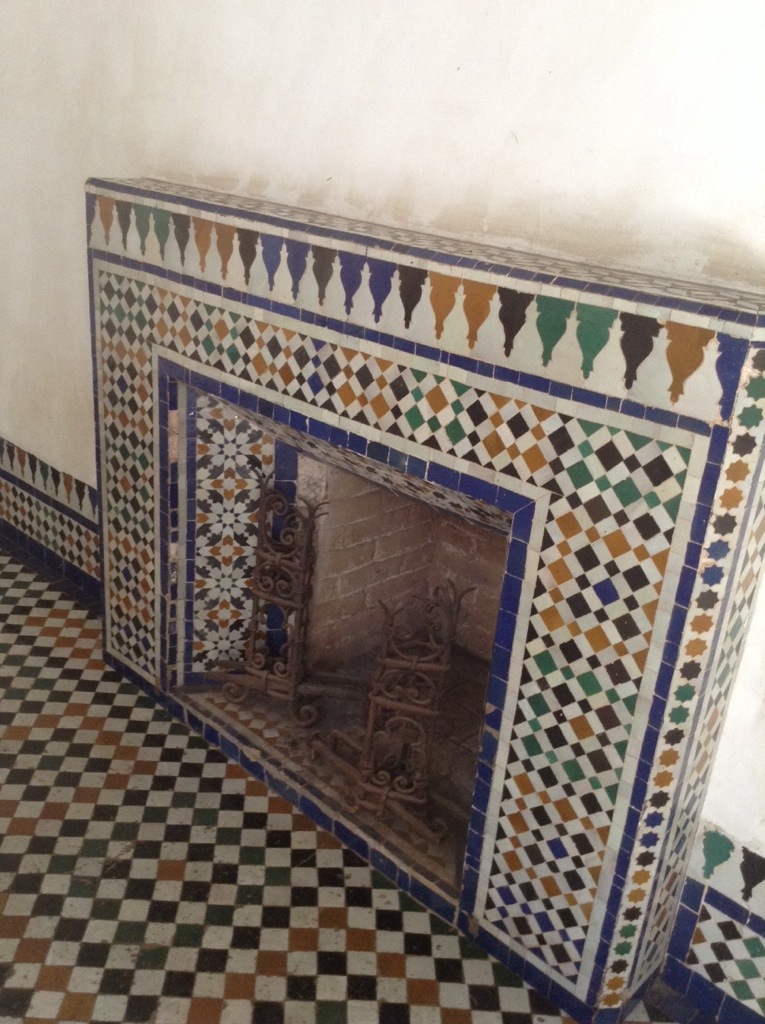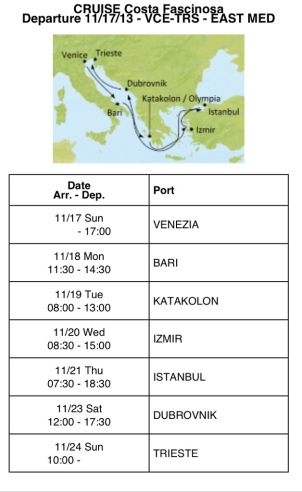by Karen
Our first full day of Marrakech, we had a simple breakfast of cereal, yogurt, and breads. One of the breads was a flat bread that reminded me of the roti that I’d used to eat as a kid in Malaysia.


Our guide picked us up at 10 and we proceeded to head out on our half-day tour of Marrakech. The guide was assigned to us by a local company that caters to one-on-one tours of interesting sights of their choosing. Our guide spoke pretty good English, though I had trouble hearing over street noise. We had a choice of going to the north side of the city closest to our riad, which was the markets, or the south side, featuring palaces and a cemetary. We chose the south.


Our guide hooked us up with a taxi and we were on our way. During the ride he pointed out various buildings of importance, and explained a bit about Islamic culture. Our first stop was in a cemetary for kings. He explained that kings were buried in the capital city during the time of their death, so a few kings were buried in Marrakech (Rabat is currently the capital of Morocco).


Some quick facts:
– Islamic art features lots of geometric shapes instead of people, so as not to worship idols or images other than god
– Green is a religious color, symbolizing Paradise (which is filled with green grass)
– The dead are buried sideways for efficiency, so bodies don’t have to be measured as much and can be buried ASAP without spectacle.
– Graves are unlabeled except for stones denoting the gender of the deceased. As our guide put it, the dead are dead, there should be no difference in how they are treated from other dead beings
– Cremation is thought to be painful for the soul, at least our guide thought being burned was more painful than being eaten by maggots (the dead can “feel”)





After the cemetary we walked through more winding roads and came upon a “palace”. It was actually an old French military building (Morocco used to be a French “protectorate”). The architecture was simply beautiful. Many of the doors and rooves were made of cedarwood, with intricate carvings on them. Tiles were arranged in symmetrical geometric patterns.






The walls are generally made of plaster since they are easier to maintain, and the floors made of tile because they are easier to clean. Many walls had engravings of the Koran etched on a downward angle, so it wouldn’t get so dusty and hard to clean.
Doors are built outside of frames and are secured by outside hinges because it is more difficult to build them in arched doorways, and it takes up more space.



After touring the building, our guide took us through more winding streets until we came to a large square–the heart of Marrakech, Jemaa-el-Fna. It was a giant marketplace, a complete sensory overload. And our tour guide pretty much dumped us there, without much direction on how to get back, other than a bus number, and the name of the stop. Without a way to call our riad, and with no wi-fi to figure out where we were, we were somewhat stranded. We did manage to find our bus and get off on the correct stop. But then we were really screwed.

We thought getting lost in Paris was bad–getting lost in the middle of Marrakech with no street signs or familiar landmarks or any semblance of main roads was worse! We were in the middle of a small square that split off into 4 different directions, none of them looking very familiar.

We were approached by a young man offering to show us the way, so we told him the name of the riad and followed him down a road–our first mistake! It didn’t look familiar at all, and he wanted some change for it. We told him we needed to get change, so he said “follow me” and started walking ahead. We quickly turned around and ran back towards the direction we had come.
After walking down a slightly more familiar path (“hey, that door looks familiar”), we managed to find our way back. Great, we thought, now that we know how to get home, let’s go back and take some pictures of important landmarks in case we get lost again.

Another young man noticed we were taking pictures and said he could help us find a way. We already knew our way home, so we said “No”. There was an old guy sitting at a shop nearby laughing, and I said “Salam”, and he was happy I said something in Arabic, so he told me that today my name was “Fatima” and Mark’s name was “Sayeed”. The young man wanted to show us a mosque where we could take photos, and the old man gave his blessing, so we said why not. We followed him, found the mosque, and took photos.


“Now you pay me 100 dirhams.”
Ah. We fell for it hook line and sinker. To be honest, we didn’t have any bills smaller than 500DH, and we didn’t want to give him anything bigger, so we told him we had no cash. He argued with us the whole way home, calling us crazy, shouting at us, and insisting that we give him money. We offered him all our coins, but he wanted bills. We got back to the shop with the old man, who smiled and shook his head with a look of “just ignore him.” As we walked back to our riad, he cursed us and turned around and left. It was actually a bit stressful, but our riad hostess assured it was a common occurrence, that it was best to not give them money to discourage their behavior.

After a bit of rest, we chatted with our hostess and she gave us a map (yay!) and directions on where to go and eat. As we walked down the street towards the square, we noticed some new graffiti near our riad that said “CRAZY CHINEES”. We eventually did bump into our “friend” again, and this time we gave him 20DH (the equivalent of $2.45) to leave us alone. He happily accepted it and went on his merry way. Lesson learned–don’t follow strangers, and don’t look so lost!
Now that we had a map, we were very careful about where we’d bring it out. Whenever we’d get lost, we’d find a bank or post office, go inside, and ask a security guard for directions. Bringing out a map or looking lost on the street causes young men everywhere to descend upon us like vultures, offering to show us where to go (of course, they all assume to know where we are going). We think it’s a ploy to get us even more lost, so we have to pay them to take us back out.
The rest of the day went by pretty smoothly, now that we had better directions and followed straight paths. After a few winding roads and ignoring cries of “this way, follow me!” and “where are you going?”, by sunset we found our way back to the giant square again.

We ate at a restaurant facing the square called Chegourani, recommended by our hostess. The prices were reasonable, and the food was amazing. We had chicken, raisin, and almond tajine, along with Moroccan soup and some veggie couscous. I noticed how in all the cities we’ve been to so far, our favorite foods involved Middle Eastern or Arabic cuisines (our favorite meal in London was Lebanese; in Paris it was Turkish). We washed it down with some strong Moroccan mint tea (needed a lot of sugar), and watched the crowds pop up as the sun went down.

After dinner, we decided to get lost in the souks. There was just so much color everywhere. We must’ve wandered around for hours, the stalls went on for miles in every direction. Eventually we decided to go back to our riad (but not without getting slightly lost). Thankfully, the photos we took of important landmarks during the day came very much in handy, as they helped us find our way home.

64.136869
-21.921866

































You must be logged in to post a comment.